Koji is our lifeblood. It is the basis of many of our fermentation experiments, the functional backbone of our pursuit for diverse flavours and umami taste. This post reviews its cultural and evolutionary history, and describes our technique for producing koji at the lab.
The Basics
Koji (kōji in Japanese, qu in Chinese, nurukgyun in Korean) is a culture made by growing different fungi on cooked grains or legumes in a warm, humid place (Shurtleff & Aoyagi 2012). The koji moulds produce many enzymes, including amylases, proteases, lipases, and tanninase, that break down (hydrolyse) macromolecules like starches, proteins, and fats into their constituent parts, such as dextrin, glucose, peptides, amino acids, and fatty acid chains (Chen et al. 2008). These simpler substrates provide nutrition for cultures of yeasts and bacteria that come in subsequent fermentation stages (Mheen 1972). The cultures are ancient technologies used to produce a variety of fermented food products, including soy sauces, jiang/miso, fermented black soybeans, and grain-based wines like sake, amazake, and li (Shurtleff & Aoyagi 2012). The most frequently occurring microorganism found in koji production is the fungus Aspergillus oryzae, but there are others that also occur, including A. sojae, A. usami, A. awamori, A. kawachii, Rhizopus spp., Monascus spp., Mucor spp., and Absidia spp. (Murooka & Yamshita 2008; Chen et al 2008).
There is a diversity of methods for koji or qu production around East Asia, using different microorganisms, wild or inoculated sources, mixed or pure cultures, and a variety of substrates. This diversity can make mapping the relationships between the different analogues tricky. For example, in English the term ‘koji’ has come to stand for all members of the family of grain-based saccharifying fermentations involving A. oryzae and related organisms, even though the Japanese word kōji refers to only one subset of the larger group of more or less loosely related cultural analogues. Korean nuruk, for example is used for making rice wine, while meju is the one used for protein-rich fermentations. Chinese qu alone encompasses a breadth of fermentations involving different substrates such as rice, sorghum, wheat, barley, peas, or soybeans, different microbial species of the genera Aspergillus spp., Rhizopus spp., Monascus spp., Mucor spp., and Absidia spp., and different techniques such as keeping mixed cultures, using various wild sources for microbes, and making the qu in loose or different pressed forms (Chen et al 2008). This diversity is in turn spread across widely different geographical areas. We generally use the Japanese word ‘koji’ to refer more broadly to the class of grain-based saccharifying fermentations involving A. oryzae, while recognizing the multitude of both different traditions and words used to describe them – this decision is mainly due to the historical introduction of the concept and word into English from the Japanese, as well as our process with koji-making starting with an eye to exploring Japanese fermentation traditions; since then, we have begun exploring some Korean and Chinese techniques as well.
To illustrate the point, here are a few examples of different qu preparations:
Hong qu – also known as ‘red yeast rice’ or ‘red fermented rice’, fermented with Monascus spp., in loose form
Xiao qu – from south China, made with rice and rice chaff, fermented with Rhizopus spp., pressed into an egg-shaped form
Mai qu – from north China, made with wheat, fermented with Aspergillus spp., pressed into a brick-shaped form
Da qu – derived from Mai qu, made with barley, wheat, and peas, fermented with Mucor spp. and Rhizopus spp., pressed into a brick
Da qu with red core – fermented with Mucor spp. and Absidia spp. (dominant), Rhizopus spp. and Aspergillus spp. (less dominant), and Monascus spp. (minority), used especially in the production of Shanxi aged vinegar
Fu qu – a more recent type, made with wheat bran, fermented with pure cultures of Aspergillus oryzae
Regardless of the diversity of its forms, the solid-state cultivation of A. oryzae seems to be the key to inducing the production of hydrolytic enzymes, which are responsible for the breakdown of macromolecules in traditional fermented foods (Machida et al. 2008).
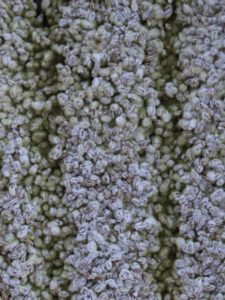
With soy sauces, most Japanese styles use roasted wheat and defatted soybean meal as a substrate for the koji, while most Chinese styles use the whole soybean for qu preparation. For more information about soy sauce production, check out our previous post on Yellow Pea Chiang Yu.
Some styles of koji production for spores (tane-koji or koji-kin) in Japan mix ash (tomo koji, lit. ‘friend of koji’) into the cooked rice, to create favourable conditions for the koji mould by increasing pH and providing certain minerals like potassium, magnesium, and phosphate, which help to increase spore production and resilience, as well as inhibiting various contaminants. The best ash is made from camellia, then zelkove (Zelkova serrata) and oak (Akita Konno).
Koji has been and continues to be referred to as a ‘malt’ by many Westerns, at least since the 19th century. This is understandable given its similar functional role in the production of grain-based wines to malt in the production of beer: that is, providing fermentable sugars. Koji and malt also share some general chemical similarities, as both saccharify starches into sugars with enzymes. The key difference, however, is that koji uses the enzymes produced by the metabolism of a living fungus, while the production of malt involves sprouting the grain and using the enzymes produced in the sprouting, after which point the enzymatic activity is halted through roasting. We have tried using fresh koji to make a mash for beer, with limited results; roasted koji has proven much more promising (more details in a later post).
At the lab, we have been growing koji on all sorts of substrates, including pearled barley, heritage barley varieties like nøgen byg, buckwheat, rye, quinoa and other Chenopodium spp., sunflower seeds, various beans, and more. Our mainstay has become pearled barley – it is what we make most often and what we know best.
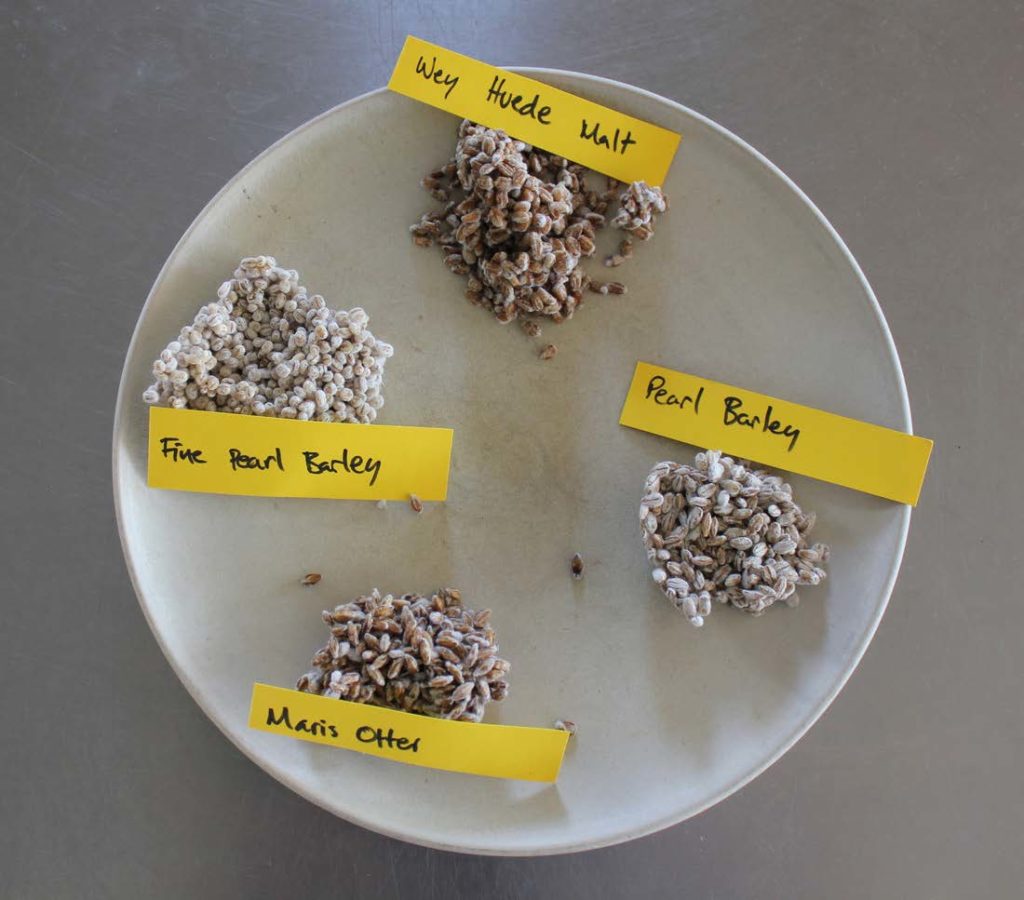
A brief history of koji
300BCE – in Zhouli (‘Rites of the Zhou dynasty’), China – the first written mention of qu. The first conceptual framework to connect soy sauces, jiangs/misos, fermented black soybeans, grain-based wines like sake and li (a Chinese precursor to Japanese amazake), and other koji-based foods.
90BCE – in Shiji (‘Records of the Historian’), by Sima Qian, China – indications that fermented black soybeans and qu were already major commodities in the Chinese economy.
100CE – in Liji (‘Book of rites’), China – the earliest known description of how grain-based wines were made from millet and rice koji.
121CE – in Shuowen Jiezi (‘Analytical Dictionary of Characters’), China – earliest known written character for qu/koji, composed of a top radical for bamboo (竹) over the character for chrysanthemum (菊). The etymology for this character interpreted by Huang (2000) stems from the idea that qu could have occurred when cooked rice was left in a bamboo basket exposed to air, which over time turned the yellow colour of chrysanthemum.
The contemporary character for koji/qu, in both Chinese and Japanese, is 麹.
544CE – in Qimin Yaoshu (‘Important Arts for the People’s Welfare’), by Jian Sixie, China – the first known detailed description of how to make qu. It includes recipes for nine types of qu and 37 types of grain-based wine.
725CE – in Harima no Kuni Fudoki (‘Geography and Culture of Harima province’), Japan – the first known written mention of koji outside of China. Made using airborne koji moulds.
965CE – in Qing Yilu (‘Anecdotes, simple and exotic’), by Tao Ku, China – the earliest known reference to hong qu, or red rice qu. It includes a recipe for red pot-roast lamb, involving lamb simmered with red rice koji.
1603 – in Vocabulario da Lingoa de Iapam (‘Vocabulary of the Language of Japan’) – Japanese-Portuguese dictionary for Jesuit missionaries in Nagasaki. Contains entries for:
Côji [Koji], a yeast [sic] used in Japan to make sake, or mixed with other things.
Amazaqe [Amazake], a still-bubbling fermented liquid that has not yet completely become sake; or sweet sake.
This is the earliest known European-language document that references koji and amazake.
1712 – in Amoenitatum exoticarum politico-physico-medicarum (‘Exotic novelties, political, physical, medical’) by Engelbert Kaempfer – Kaempfer traveled and lived in Japan from September 1690 to November 1692, mentioning koji, or ‘koos’ as he called it, as part of the process of making miso.
1766 – Samuel Bowen, an American, begins producing, selling, and exporting Chinese-style soy sauce in Thunderbolt near Savannah, Georgia based on a technique he learned in China. Bowen was the first to introduce the soybean to North America (Hymowitz & Harlan 1983).
1779 – in Encyclopaedia Britannica, 2nd edition – the entry for ‘Dolichos’ mentions ‘koos’ (after Kaempfer).
1818 – in Account of a Voyage of Discovery to… the Great Loo-Choo Island [Ryukyu, or Okinawa], by Basil Hall – “…hard boiled eggs, cut into slices, the outside of the white being colored red.” This red colour was likely imparted to the outside of the shelled eggs by red rice koji, known in Japan as beni-koji.
1867 – in A Japanese and English Dictionary, by James C. Hepburn – the first written occurrence of koji referred to as a ‘malt’.
1878 March 10 – in Koji no setsu (‘Theory of Koji’), published in Japanese in Tokyo Iji Shinshi (Tokyo Medical Journal) by H. Ahlburg and Shinnosuke Matsubara – the first scientific article ascribing a latin binomial to koji mould. Ahlburg named the mould Eurotium oryzae, which was later renamed Aspergillus oryzae by Cohn in 1884. Japanese scientists rapidly adopting Western microbiology.
1878 Sept 12 – in Brewing in Japan, by R.W. Atkinson, British professor at University of Tokyo, published by Nature (London) – the earliest English-language document that mentions ‘tane’, or koji spores, and ‘tomo koji’, or wood ash.
1881 May 1 – R.W. Atkinson explicitly distinguishes koji from malt, and insists on the use of the Japanese word in English to avoid “erroneous impressions”.
1891 Feb 20 – The first article (appearing in the Chicago Daily Tribune) about Jokichi Takamine, a Japanese chemist residing in Chicago who developed method of using koji instead of malt to make whiskey, with 12-15% improvement in efficiency.
1894 Feb 23 – Takamine applies for a patent for ‘Taka-Diastase’, now known as the amylase produced by Aspergillus oryzae. This is the first US patent for a microbial enzyme.
1895 July – Takamine contracts with Parke, Davis & co. of Detroit, Michigan to manufacture and market Taka-Diastase on a large commercial scale. This is the earliest known commercially-produced enzyme in North America.
1897 – Yamamori Jozo-sho in San Jose, CA is the earliest-known company to produce shoyu (Japanese soy sauce) in the US.
1906 – Karuhorunia Miso Seizo-jo (California Miso Manufacturing Co.) in San Francisco is the earliest-known company to make miso in the US.
1908 – Kodama Miso Seizo-sho in Los Angeles is the earliest-known company to make and sell koji in the US, advertising its product as ‘Shiro Koji’.
1913 – Marusan Joto Shiromiso in Los Angeles is the earliest-known company to sell and advertise koji in English, as ‘Special Koji’.
1972 – The Erewhon Trading Co., Inc. catalog entitled ‘Traditional Foods’ advertises its koji imported from Japan. At this point there was a resurgent interest in koji in North America with the macrobiotic, natural-foods, and soyfoods movements.
2004 – Professor emeritus Eiji Ichishima of Tohoku University, Japan, proposes in Nippon Jozo Kyokai Zasshi (Journal of the Brewing Society, Japan) that Aspergillus oryzae become the ‘national fungus’ (kokkin), just like a national bird, flower, tree, or animal. The proposal is approved at the society’s annual meeting in 2006.
It should be noted that while the dominant popular narrative surrounding the flow of ideas – and associated structures of power – in the world has gone from ‘West’ to ‘East’, in the case of koji technology the knowledge has moved from East Asia to Europe and North America – very much the opposite.
For more information about the history of koji, look into the extensive book by Shurtleff and Aoyagi from 2012 called ‘The History of Koji’, available free online.
Evolutionary history and domestication
The evolutionary history of Aspergillus oryzae provides an interesting model for investigating mechanisms of domestication, and how they might differ in microbes compared to animals or plants.
The closest relative to A. oryzae is A. flavus, the two species sharing 99.5% genome-wide nucleotide similarity. Yet this difference is enough for the species to exhibit markedly different metabolic and behavioural characteristics. Though under certain conditions (mainly incubation longer than the standard three days for koji fermentation) some strains of A. oryzae have been shown to produce mycotoxins such as maltoryzine, ochratoxin A, and kojic, aspergillic, cyclopiazonic, and b-nitropropionic acids (USEPA 2012; Ciegler & Vesonder, 1987; Blumenthal 2004), the fungus has been used safely in food production for centuries, is Generally Regarded As Safe (GRAS) by the United States Food and Drug Administration (FDA), and has Qualified Presumption of Safety (QPS) by the European Food Safety Authority (EFSA). A. flavus, on the other hand, is an agricultural pest of several seed crops and producer of aflatoxin, another mycotoxin and one of the most potent naturally-occurring carcinogens.
In a 2012 study, Gibbons et al. compared the genome sequences of 14 geographically and industrially diverse strains of A. oryzae and A. flavus with their reference strains to learn more about the flavus-oryzae lineage and “the functional changes associated with microbe domestication and the impact of the process on genome variation.” Firstly, they found that the genome-wide nucleotide diversity among the A. oryzae strains was around 25% of that among the A. flavus strains. This result, paired with the knowledge that A. oryzae is monophyletic, indicates that all strains of A. oryzae originate from a single domestication event i.e. one common ancestor. Furthermore, two of the A. flavus isolates showed a closer affinity to A. oryzae than to the other A. flavus isolates, suggesting not only that A. oryzae descended from A. flavus but that it likely originated within an atoxigenic clade of A. flavus. Some strains of A. flavus are indeed known to be atoxigenic, so such an origin is evolutionarily plausible.
Some of the possible selective pressures for A. oryzae are illustrated by the relationship between koji and sake production. Aflatoxin is genotoxic to Saccharomyces cerevisiae, the principal yeast involved in the fermentation of sake and other grain-based wines, which means that evolution of the atoxigenic A. oryzae and/or its atoxigenic A. flavus ancestor could have been driven in part by its impact on yeast survival (Gibbons et al. 2012). In other words, that saccharification and alcoholic fermentation occur in parallel in many methods for sake production means that a less toxigenic saccharifying mould would allow for a stronger culture of alcoholically fermenting yeast, enhancing the production of sake and leading to alcohol levels up to 18-20% by volume – the highest recorded level of alcohol in a beverage without distillation (Murooka & Yamshita 2008). The fact that humans like alcohol probably directly selected for a non-toxic strain of saccharifying mould – leading to a technology with many applications beyond alcoholic fermentation itself.
Overall, what has emerged from this and other studies is a picture of microbe domestication different from that with many animals and plants: while domestication of many plant and animal species has been largely effected through “genetic tinkering” of developmental pathways affecting growth and morphology, the domestication of some microbes including A. oryzae was driven by the restructuring of metabolism (Gibbons et al. 2012).
Making Koji
Now we can make some koji. This recipe yields about 1450g of finished koji from 1 kg of dry pearled barley.
You will need:
1kg dry pearled barley, or another grain (it is worth noting that in sake production, the more polished/pearled the grain of rice, the more expensive the sake)
sufficient water for soaking
~30g koji-kin / tane-koji / koji spores
a thermomix, or strong blender, or mortar and pestle (in this case less than ideal)
a steam oven, or something to steam in, or a slow cooker, or a pot of boiling water (as a last resort)
hand sanitiser
latex gloves
a gastrotray, or another similar tray
a clean cloth that can cover the tray
a koji chamber (we use an upright fridge turned off and fitted with heating mat and temperature probe connected to PID controller – essentially some place that can maintain a constant temperature of 30˚C and retain humidity, and has some space for airflow. For more information on creating a similar device, check out our previous post ‘Home Made’).
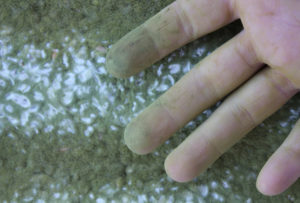
1. Soak pearled barley overnight.
2. The next morning, turn on koji chamber to 30˚C.
3. Steam barley (100˚C) for 90 minutes in perforated gastro tray.
3. Remove barley from oven. While it cools, blitz koji-kin in thermomix to a fine powder (~20g koji-kin / 1kg cooked barley).
4. Once barley has cooled to a comfortable temperature, sanitize hands with alcohol, put on latex gloves and break up chunks thoroughly. Pour or scoop barley into standard full-size gastros to a depth of about 2cm.
5. Prepare a warm, damp, wrung-out cloth to cover the koji.
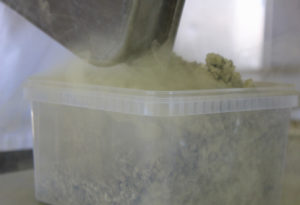
6. When the barley has reached 35˚C, inoculate with powdered koji-kin and mix thoroughly to coat every grain. Smooth out barley and cover with the damp cloth.
7. Place the tray into the koji chamber (time T+0). Fill from the top racks down, to make use of the most heat. The barley should stay around 30˚C, and not go too far above. Place the temperature probe into the barley itself to keep track of the internal temperature – this is crucial to not letting it overheat. Put it in the koji chamber on the uppermost shelf, as it is in the warmest part of the chamber. Close door.
8. At T+18h, remove tray and turn the koji – mixing to aerate and ensure even distribution of spores. It should start to smell fruity and fragrant. Redampen the cloth, cover and return to chamber. Nestle the probe into the koji on the top shelf. Close door. Monitor the temperature carefully over the next 18h – it should stay between 25˚C and 30˚C in order to not denature any of the peptidases, and certainly no higher than 38˚C, which will kill the mould.
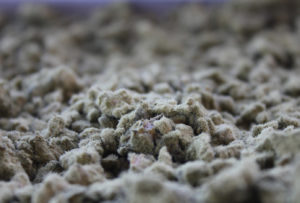
9. At T+24h, turn koji again. This time, create two furrows in the koji lengthwise with hands – the furrows should be as deep as possible without being able to see the pan through the grains. Return the koji to the chamber with a newly dampened cloth. Nestle the probe into the top shelf koji. This time, keep the chamber door open a crack to prevent overheating.
10. At T+30h, turn the koji a final time, again with furrows. Lightly re-dampen the cloth (at this point the chamber should be around 95% relative humidity) and return the koji to the chamber. Nestle the probe into the top shelf koji with the door slightly cracked.
11. At T+36, the A. oryzae mycelia will have permeated the grains and they will hold together in a spongy white cake.
12. If using koji for further fermentation, use while it is still white. If saving koji as koji-kin, let the A. oryzae continue to develop until it begins to sporulate and turn green. Once it turns green, break it up in the tray and let it dry slowly, somewhere warm and dry. Once completely dry, store and use for future koji inoculation.
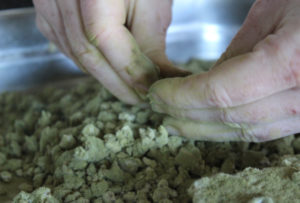
13. Happy fermenting!
Troubleshooting:
If the koji turns sticky and starts to smell ammoniated and like sour bananas, the A. oryzae has probably been killed due to an excessive temperature, and the substrate has been taken over by Bacillus subtilis – bacteria that are often found in certain alkali fermentations. It is the reason why natto is sticky and ammoniated. Discard, and next time be sure to keep the temperature in the center of the grains around 30˚c. It might take some experimenting to get it right depending on your incubation set-up.
References
Akita Konno Co., Ltd. “Outline of Koji and Yeast Stater [sic] producing process”. Japan. 17 Dec 2013. <http://www.akita-konno.co.jp/en/dekirumade/index.html>.
“Aspergillus oryzae”. Wikipedia. Sept 3 2013. Nov 24 2013. <en.wikipedia.org/wiki/Aspergillus_oryzae>.
“Aspergillus oryzae Final Risk Assessment”. Biotechnology Program under the Toxic Substances Control Act (TSCA), United States Environmental Protection Agency. 27 Sept 2012. 23 Dec 2013. <http://www.epa.gov/biotech_rule/pubs/fra/fra007.htm>.
Chen, Fusheng et al. “Cereal Vinegars Made by Solid-State Fermentation in China”. . 2008.
Gibbons, John et al. “The Evolutionary Imprint of Domestication on Genome Variation and Function of the Filamentous Fungus Aspergillus oryzae”. Current Biology. 22: 1403-1409 (2012).
Glenn, Dianne and Rogers, Peter. “Industrialization of Indigenous Fermented Food Processes: Biotechnological Aspects”.
Hammes, Walter et al. “Microbial ecology of cereal fermentations”. Trends in Food Science & Technology. 16: 4-11 (2005).
Hui, Y. H. et al. Handbook of Food and Beverage Fermentation Technology. New York: Marcel Dekker Inc., 2004.
Machida, Masayuki et al. “Genome sequencing and analysis of Aspergillus oryzae”. Nature. 438: 1157-1161 (2005).
Machida, Masayuki et al. “Genomics of Aspergillus oryzae: Learning from the History of Koji Mold and Exploration of Its Future”. DNA Research. 15: 173-183 (2008).
Mheen, T I (1972). Korean fermented foods. Selected paper from the UNESCO Work Study on Waste Recovery by Microorganisms, University of Malaya, Kuala Lumpur, Malaysia.
Murooka, Yoshikatsu and Yamshita, Mitsuo. “Traditional healthful fermented products of Japan”. Journal of Industrial Microbial Biotechnology. 35: 791-798 (2008).
Nielsen, Dennis et al. “Mixed microbial Fermentations and methodologies for their investigation”. Unpublished.
Shurtleff, William and Aoyagi, Akiko. History of Koji – Grains and/or soybeans enrobed with a mold culture (300BCE to 2012). USA: Soyinfo Center, 2012. 17 July 2013. 17 Dec 2013. <http://www.soyinfocenter.com/pdf/154/Koji.pdf>.
Tzean, SS et al. “Aspergillus oryzae var. effusus”. BCRC. Taiwan: Gifu University, 1990. Nov 24 2013. <http://www.bcrc.firdi.org.tw/fungi/fungal_detail.jsp?id=FU20080222000>.
